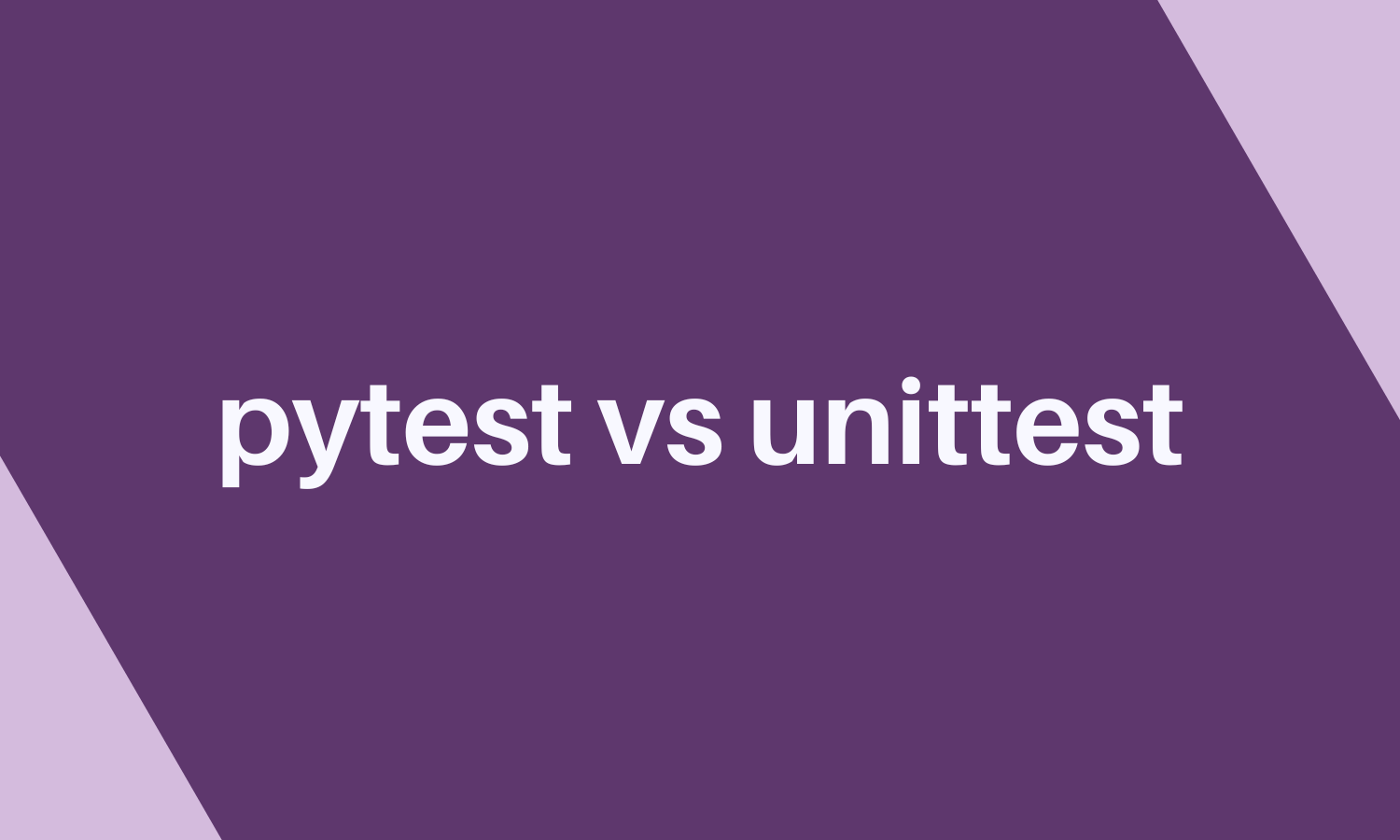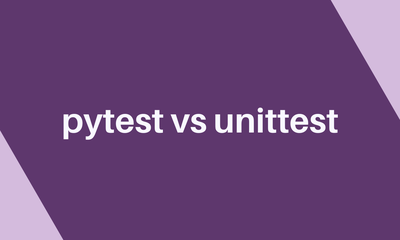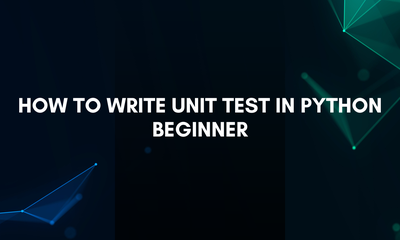So sánh Pytest và Unittest
By JoeVu, at: 21:52 Ngày 02 tháng 3 năm 2023
Thời gian đọc ước tính: __READING_TIME__ phút


Viết các trường hợp kiểm thử là một phần quan trọng trong phát triển phần mềm, và hai trong số các framework kiểm thử Python phổ biến và được sử dụng rộng rãi nhất là pytest và unittest. Chúng có những cách tiếp cận khác nhau trong việc viết các bài kiểm thử, và trong bài viết này, chúng ta sẽ xem xét sự khác biệt giữa chúng và cách chúng so sánh với nhau. Chúng ta sẽ xem xét những ưu điểm và nhược điểm của mỗi framework, và cũng cung cấp một số lời khuyên về khi nào nên sử dụng mỗi framework.
1. Giới thiệu
1.1. unittest là gì?
Python unittest là một framework kiểm thử đơn vị là một phần của Thư viện Chuẩn Python. Unittest giúp các nhà phát triển tự động hóa các trường hợp kiểm thử và đảm bảo rằng mã của họ hoạt động như mong đợi. Unittest dựa trên kiến trúc xUnit và thường được sử dụng trong Phát triển điều khiển bằng kiểm thử (TDD).
Một bài kiểm thử đơn vị là một đoạn mã được viết bởi một nhà phát triển để kiểm thử một đơn vị chức năng duy nhất trong phần mềm. Đó là một quy trình tự động để xác nhận rằng mã hoạt động như mong đợi. Các bài kiểm thử đơn vị được viết để kiểm tra các trường hợp biên và đảm bảo mã hoạt động trong các kịch bản khác nhau.
Ví dụ, giả sử chúng ta có một hàm tính diện tích của một hình tròn. Chúng ta có thể sử dụng unittest để xác nhận rằng hàm hoạt động chính xác. Chúng ta có thể tạo một lớp kiểm thử với phương thức setUp() để tạo các đối tượng chúng ta cần và sau đó viết các bài kiểm thử của chúng ta.
Tệp test_circle_area.py
import unittest
class TestCircleArea(unittest.TestCase):
def setUp(self):
self.radius = 5
def test_area(self):
result = self.radius**2*3.14
self.assertEqual(result, 78.5)
Chạy kiểm thử
python -m unittest test_circle_area.py
Trong ví dụ này, chúng ta tạo một lớp kiểm thử có tên TestCircleArea và một phương thức setUp để tạo các đối tượng chúng ta cần. Sau đó, chúng ta định nghĩa một phương thức test_area() sử dụng phương thức assertEqual() để kiểm tra xem kết quả có bằng 78.5 hay không. Nếu có, thì bài kiểm thử sẽ thành công. Nếu không, thì bài kiểm thử sẽ thất bại.
1.2. Pytest là gì?
Pytest là một framework kiểm thử phổ biến cho Python. Nó được thiết kế để đơn giản, có thể mở rộng và mạnh mẽ. Đó là một framework giúp việc viết và chạy các bài kiểm thử dễ dàng hơn bằng cách cung cấp các công cụ để sắp xếp và chạy các bài kiểm thử cũng như thu thập và hiển thị kết quả. Pytest hỗ trợ nhiều tính năng bao gồm khám phá kiểm thử, fixtures, assertions và nhiều hơn nữa.
Một ví dụ về việc sử dụng Pytest là để kiểm thử một hàm cộng hai số. Sau đây là một đoạn mã mẫu:
Tệp test_add.py
def add(x, y):
return x + y
def test_add():
assert add(2, 3) == 5
Chạy kiểm thử
pytest test_add.py
Mã trên sử dụng framework Pytest để kiểm thử hàm add(). Nếu assertion thành công, thì bài kiểm thử sẽ thành công. Nếu assertion thất bại, thì bài kiểm thử sẽ thất bại. Pytest sẽ báo cáo kết quả của bài kiểm thử, bao gồm cả bất kỳ lỗi nào gặp phải.
2. Lợi ích của unittest
2.1. Dễ sử dụng
Python unittest dễ sử dụng và có cú pháp và cấu trúc đơn giản. Viết các bài kiểm thử đơn giản hơn và nhanh hơn so với các framework khác.
2.2. Mạnh mẽ
Python unittest là một framework mạnh mẽ có thể xử lý các kịch bản kiểm thử phức tạp. Nó có thể mở rộng và có thể được sử dụng để kiểm thử nhiều loại ứng dụng khác nhau.
2.3. Toàn diện
Python unittest cung cấp một bộ tính năng toàn diện để kiểm thử. Nó bao gồm hỗ trợ khám phá kiểm thử, assertions, test fixtures và mocking.
2.4. Linh hoạt
Python unittest rất linh hoạt và có thể được sử dụng để kiểm thử nhiều loại ứng dụng khác nhau. Nó có thể được tích hợp với các framework và thư viện khác để tạo ra một bộ kiểm thử mạnh mẽ.
2.5. Khả năng mở rộng
Python unittest có khả năng mở rộng cao và có thể được sử dụng để kiểm thử các ứng dụng lớn. Nó được thiết kế để xử lý các dự án lớn, phức tạp với nỗ lực tối thiểu.
3. Lợi ích của Pytest
3.1. Dễ sử dụng
Python pytest có một API đơn giản và trực quan giúp dễ dàng viết và thực thi các bài kiểm thử đơn vị. Nó tuân theo phương pháp “quy ước trên cấu hình”, có nghĩa là nó yêu cầu thiết lập và cấu hình tối thiểu.
3.2. Thư viện Assertions toàn diện
Python pytest cung cấp một bộ assertions toàn diện để kiểm thử hành vi của mã. Nó cũng bao gồm các assertions tích hợp sẵn cho các tình huống phổ biến, chẳng hạn như kiểm tra đầu ra của một hàm hoặc xác minh giá trị của một biến.
3.3. Fixtures linh hoạt
Python pytest cung cấp một hệ thống fixture mạnh mẽ cho phép các nhà phát triển dễ dàng thiết lập và dọn dẹp tài nguyên cho các bài kiểm thử của họ. Fixtures có thể được sử dụng để thiết lập cơ sở dữ liệu, các đối tượng mock hoặc bất kỳ tài nguyên nào khác cần thiết cho các bài kiểm thử.
3.4. Tham số hóa bài kiểm thử
Python pytest cho phép các nhà phát triển dễ dàng tham số hóa các bài kiểm thử của họ. Điều này giúp dễ dàng chạy cùng một bài kiểm thử với các đầu vào khác nhau hoặc kiểm thử các kịch bản khác nhau trong một bài kiểm thử duy nhất.
3.5. Thực thi song song
Python pytest hỗ trợ chạy các bài kiểm thử song song, điều này có thể làm giảm đáng kể thời gian cần thiết để chạy toàn bộ bộ kiểm thử.
4. So sánh unittest và Pytest
4.1. Cú pháp
Sự khác biệt chính giữa Python unittest và pytest là cú pháp và các tính năng mà chúng cung cấp. Python unittest sử dụng thiết lập kiểu xUnit truyền thống với các bài kiểm thử dựa trên lớp và các câu lệnh assert, trong khi pytest cung cấp cú pháp ngắn gọn hơn, dễ viết và đọc hơn.
Ví dụ, giả sử chúng ta muốn kiểm thử một hàm kiểm tra xem một số là chẵn hay lẻ. Trong Python unittest, chúng ta sẽ viết một cái gì đó như thế này:
import unittest
def is_even(number):
return number % 2 == 0
class TestIsEven(unittest.TestCase):
def test_is_even_with_even_number(self):
self.assertTrue(is_even(4))
def test_is_even_with_odd_number(self):
self.assertFalse(is_even(3))
if __name__ == '__main__':
unittest.main()
Trong pytest, bài kiểm thử này có thể được viết đơn giản hơn và ít dòng mã hơn, như thế này:
import pytest
def is_even(number):
return number % 2 == 0
@pytest.mark.parametrize("num, expected", [
(4, True),
(3, False)
])
def test_is_even(num, expected):
assert is_even(num) == expected
Nhìn chung, Python unittest là một lựa chọn tốt cho người mới bắt đầu vì nó dễ học, nhưng các nhà phát triển có kinh nghiệm có thể thích pytest hơn vì cú pháp ngắn gọn và các tính năng bổ sung của nó.
4.2. Tổ chức kiểm thử
Pytest sử dụng phương pháp mô-đun để tổ chức kiểm thử, trong đó các bài kiểm thử được tổ chức thành các mô-đun kiểm thử. Điều này giúp dễ dàng tổ chức các bài kiểm thử thành các nhóm logic và cho phép các nhà phát triển chạy các bài kiểm thử riêng lẻ hoặc các mô-đun kiểm thử.
Mặt khác, Unittest sử dụng phương pháp dựa trên lớp để tổ chức kiểm thử. Điều này có nghĩa là các bài kiểm thử được tổ chức thành các lớp, có thể được chia nhỏ hơn nữa thành các phương thức kiểm thử. Việc tổ chức này giúp dễ dàng chia sẻ mã thiết lập và dọn dẹp chung giữa các bài kiểm thử, nhưng có thể làm cho việc chạy các bài kiểm thử riêng lẻ hoặc các mô-đun kiểm thử khó khăn hơn.
4.3. Báo cáo lỗi
Pytest báo cáo lỗi với nhiều chi tiết hơn và cung cấp nhiều thông tin hơn so với unittest. Chi tiết bổ sung này có thể giúp các nhà phát triển nhanh chóng xác định nguồn gốc của lỗi và khắc phục chúng. Pytest cũng cung cấp báo cáo lỗi chính xác và ngắn gọn hơn, giúp các nhà phát triển dễ dàng gỡ lỗi và giải quyết chúng hơn.
Khi nói đến báo cáo lỗi, unittest sử dụng phương pháp cơ bản hơn. Thông báo lỗi của nó tổng quát hơn nhiều và không cung cấp nhiều chi tiết như pytest. Điều này làm cho việc xác định nguồn gốc của lỗi và giải quyết chúng khó khăn hơn.
4.4. Fixtures
Trong pytest, fixtures được sử dụng để thiết lập dữ liệu kiểm thử trước khi các bài kiểm thử được chạy và để dọn dẹp sau khi các bài kiểm thử đã chạy. Fixtures cũng có thể được sử dụng để tiêm các phụ thuộc hoặc các đối tượng mock vào các bài kiểm thử. Trong unittest, fixtures được sử dụng để thiết lập và dọn dẹp môi trường trước và sau khi các bài kiểm thử được chạy.
4.5. Hiệu năng
Pytest linh hoạt hơn và có nhiều tính năng hơn unittest, chẳng hạn như các câu lệnh assert tích hợp sẵn, tham số hóa kiểm thử và khám phá kiểm thử tự động. Điều này cho phép bạn viết các bài kiểm thử toàn diện hơn với ít mã hơn và do đó ít thời gian hơn cần thiết để chạy chúng.
Pytest cũng có hỗ trợ tốt hơn cho các plugin của bên thứ ba, điều này có thể giúp cải thiện tốc độ chạy kiểm thử hơn nữa. Các plugin này có thể được sử dụng để tăng tốc độ thực thi của một số bài kiểm thử nhất định hoặc để thêm các tính năng như phạm vi bảo hiểm mã và lập hồ sơ.
5. Kết luận
Pytest và unittest đều là những công cụ tuyệt vời để kiểm thử mã. Cả hai đều phổ biến, được hỗ trợ tốt và có cộng đồng mạnh mẽ. Sự khác biệt chính giữa chúng là pytest đơn giản hơn, hỗ trợ nhiều tính năng kiểm thử nâng cao hơn và dễ sử dụng hơn. Unittest dài dòng hơn, yêu cầu nhiều thiết lập và bảo trì hơn và ít linh hoạt hơn.
Đối với hầu hết các nhà phát triển, tôi khuyên bạn nên sử dụng pytest vì tính dễ sử dụng và các tính năng nâng cao của nó. Tuy nhiên, nếu bạn cần duy trì mã unittest cũ, thì bạn nên sử dụng unittest. Cuối cùng, điều này phụ thuộc vào sở thích của các nhà phát triển và nhu cầu của dự án.
Bạn có thể tìm hiểu thêm về Python unittest trong các bài đăng trên blog của chúng tôi
Tài liệu tham khảo





